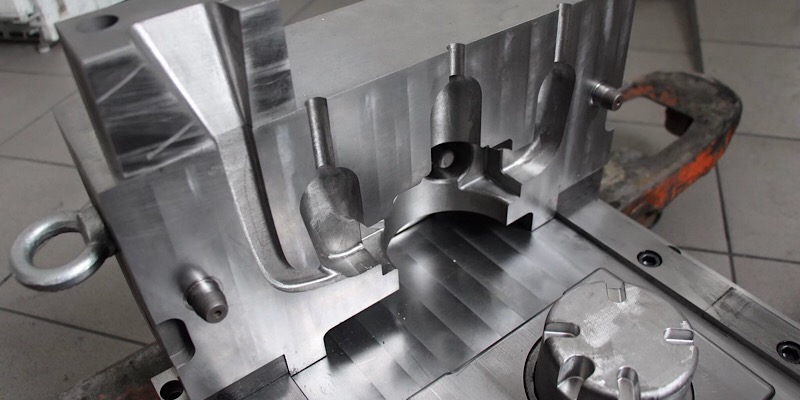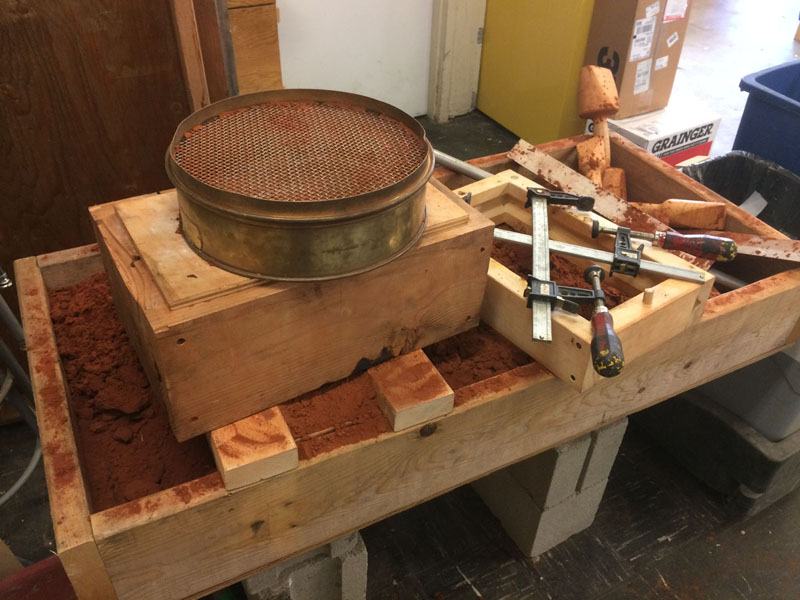Aluminum Foundry Wisconsin delivers strong casting performance
Exactly How Aluminum Foundry Adds To Developments in Aerospace Engineering
Aluminum foundries are indispensable to advancements in aerospace engineering. They generate lightweight, high-strength parts that are vital for modern-day airplane. Through advanced spreading strategies, these shops develop complicated geometries that enhance architectural honesty. Additionally, the advancement of premium Aluminum alloys sustains the sector's concentrate on fuel performance and sustainability. Difficulties stay in the manufacturing process. Understanding these aspects exposes the extensive effect of Aluminum on aviation's future.
The Significance of Lightweight Materials in Aerospace Design
As the aerospace sector remains to evolve, the importance of light-weight products ends up being progressively noticeable. The demand for performance and sustainability drives designers to prioritize the usage of products that minimize overall weight without endangering structural integrity. Lightweight products, specifically Aluminum, play a vital function in enhancing gas effectiveness, boosting haul capacity, and enhancing the total performance of aircraft.
The assimilation of these products permits for ingenious styles, making it possible for makers to develop more wind resistant forms that can endure severe problems. The reduction in weight not only reduces operational costs but additionally adds to a decreased environmental impact, straightening with international efforts towards sustainability in aeronautics.
Advanced Spreading Techniques in Aluminum Foundries
Advanced casting strategies in Aluminum foundries play an important duty in aerospace design by enabling the production of lightweight and accurate components. Innovations in mold and mildew style and precision spreading procedures are vital in accomplishing perfect efficiency and structural honesty. Furthermore, the development of light-weight alloys improves the overall performance and efficiency of aerospace applications.
Innovative Mold And Mildew Design
Innovative mold design plays a crucial role in the effectiveness and efficiency of Aluminum shops, especially within the aerospace industry. By leveraging sophisticated materials and methods, modern-day molds can be crafted to endure high temperature levels and pressures, making certain peak performance during the spreading process. These layouts typically integrate intricate geometries that enable the manufacturing of lightweight yet structurally sound components, important for aerospace applications. Additionally, using computer-aided design (CAD) software program helps with specific modeling, allowing shops to fine-tune and simulate mold layouts before physical production starts. This not just enhances the high quality of actors components yet likewise lowers waste and lead times, leading to significant cost financial savings. In general, cutting-edge mold and mildew layout is a keystone of progress in Aluminum Foundry innovation for aerospace design.
Accuracy Casting Procedures
The performance of cutting-edge mold and mildew designs seamlessly integrates with precision casting processes, which are vital for creating high-quality Aluminum components in aerospace engineering. These procedures, consisting of sand casting, pass away spreading, and financial investment casting, ensure the development of complicated geometries with tight tolerances. Advanced techniques like vacuum cleaner spreading and stress pass away casting boost the stability and surface finish of the end products. Precision spreading reduces product waste while maximizing the mechanical residential or commercial properties of Aluminum, important for aerospace applications. On top of that, utilizing real-time monitoring and progressed simulation devices throughout the casting process permits prompt modifications, resulting in enhanced quality assurance. Collectively, these accuracy spreading processes setting Aluminum foundries at the forefront of aerospace development, sustaining the industry's need for dependability and efficiency.
Lightweight Alloy Development
As aerospace designers seek to enhance fuel effectiveness and efficiency, lightweight alloy growth ends up being a necessary emphasis in Aluminum foundries. These factories utilize advanced spreading methods to produce alloys that provide superior strength-to-weight proportions. Technologies in alloy structure, including the unification of aspects like lithium and magnesium, allow the manufacturing of materials that withstand extreme problems while minimizing overall airplane weight. Methods such as die casting and financial investment spreading assist in the accuracy manufacturing of intricate forms, which are essential for aerospace applications. Furthermore, recurring research intends to maximize these alloys for enhanced mechanical homes and raised toughness. By prioritizing lightweight alloy growth, Aluminum shops significantly contribute to the evolution of aerospace design, leading the way for extra lasting and reliable aircraft designs.

Enhancing Architectural Integrity With Aluminum Elements
Aluminum parts supply substantial advantages in enhancing architectural integrity within aerospace engineering. Their light-weight nature adds to total efficiency while keeping toughness, which is vital for aircraft efficiency. Furthermore, the stress and anxiety resistance buildings of Aluminum assistance ensure the sturdiness and integrity of aerospace frameworks under different functional conditions.
Light-weight Material Perks
While traditional materials frequently endanger weight for strength, utilizing Aluminum components in aerospace engineering offers substantial advantages in architectural stability. Aluminum's light-weight nature adds to total style performance, enabling even more streamlined aircraft that take in much less fuel, therefore improving sustainability. The material's superb strength-to-weight ratio assurances that components preserve toughness without adding unneeded mass. This high quality fosters improved performance and agility in trip, in addition to optimized payload capacities. Additionally, Aluminum's resistance to corrosion prolongs the lifespan of aerospace frameworks, minimizing maintenance prices and enhancing security. As suppliers progressively take on Aluminum alloys, the aerospace market experiences a transformative shift in the direction of much more effective and efficient design options that focus on both performance and ecological duty.
Tension Resistance Features
Although various materials have special properties, Aluminum's outstanding anxiety resistance sticks out as an important consider boosting the structural stability of aerospace elements. This resistance plays a crucial role in making sure that airplane can withstand various functional stresses, consisting of fatigue, impact, and environmental conditions. Aluminum alloys, especially crafted for aerospace applications, show high tensile strength while maintaining lightweight features, enabling engineers to make extra effective structures - Aluminum Foundry. Furthermore, the ability of Aluminum to withstand cyclic loading without substantial contortion adds to the durability and dependability of aerospace elements. As advancements continue in Aluminum Foundry strategies, the advancement of stress-resistant Aluminum components assures additional renovations in efficiency, security, and efficiency throughout the aerospace sector, solidifying Aluminum's duty as a recommended material in modern design
Fuel Effectiveness Improvements Driven by Aluminum Innovations
As the aerospace sector looks for to enhance fuel efficiency, innovative uses this hyperlink of Aluminum have actually become a crucial option. Aluminum's light-weight nature especially reduces airplane weight, enabling lower gas usage throughout flight. This decrease in weight is vital, as even small decreases can bring about considerable improvements in overall gas economic situation.
Advanced Aluminum alloys, made for enhanced stamina and longevity, enable manufacturers to create parts that keep architectural honesty while reducing mass - Aluminum Foundry. Additionally, the combination of Aluminum in airframes and engine elements assists in improved aerodynamics, adding to decreased drag and increased efficiency
The adoption of Aluminum in aerospace not only meets the need for fuel-efficient design yet also aligns with regulative stress for reduced emissions. As these technologies remain browse around this site to advance, they play a considerable function in setting brand-new criteria for gas efficiency, making certain that the aerospace field can satisfy growing environmental and economic challenges.

The Duty of Aluminum in Sustainable Aeronautics Practices
The raising emphasis on lasting air travel techniques has actually placed Aluminum as a crucial material in the mission for greener airplane layout. Recognized for its lightweight residential or commercial properties, Aluminum substantially decreases aircraft weight, bring about reduced gas consumption and discharges. Its recyclability better boosts its sustainability profile, as Aluminum can be reused forever without loss of high quality. This particular supports a circular economic situation within the aviation industry, lessening waste and source depletion.
Improvements in Aluminum alloys have boosted their strength and rust resistance, allowing for longer service life and minimized upkeep needs. These technologies help with the growth of extra efficient aircraft structures, adding to general sustainability initiatives. In addition, Aluminum's thermal conductivity plays a critical duty in energy-efficient layouts, enhancing systems such as warmth exchangers. Collectively, these features underscore Aluminum's essential function in advancing sustainable air travel, lining up with global initiatives focused on lowering the ecological impact of air travel.
Obstacles Faced by Aluminum Foundries in Aerospace Manufacturing
While Aluminum foundries play a crucial role in aerospace manufacturing, they encounter considerable challenges that can impact production efficiency and quality. One significant obstacle is the rigid quality control criteria required in the aerospace market. Any type of flaw can jeopardize security and performance, requiring strenuous evaluation processes that prolong manufacturing timelines. Additionally, foundries often emulate changing raw product expenses, which can influence prices and success. The complexity of Aluminum alloys used in aerospace applications further makes complex the manufacturing procedure, as accurate formulas are crucial for achieving desired mechanical residential or commercial properties. Moreover, competent labor scarcities prevent the capacity to maintain high-quality production degrees. Ultimately, environmental policies impose constraints on discharges and waste management, needing foundries to invest in lasting methods, which can be cost-prohibitive. These factors jointly develop a landscape where Aluminum factories must constantly adapt to fulfill the progressing needs of aerospace manufacturing while making sure security and conformity.
Future Patterns in Aluminum Applications for Aerospace Design
With advancements in modern this link technology and boosting demands for performance, the future of Aluminum applications in aerospace engineering is positioned for considerable change. The assimilation of ingenious Aluminum alloys and composites is expected to boost strength-to-weight ratios, leading to more fuel-efficient airplane designs. Furthermore, developments in additive production techniques will permit the production of complicated Aluminum frameworks that were previously difficult, enhancing efficiency and minimizing waste.

Sustainable techniques will play an important duty, with a growing focus on recycling Aluminum to minimize environmental effect. The aerospace field is likely to embrace smarter manufacturing processes, such as automation and synthetic intelligence, making sure better and accuracy in Aluminum components. In addition, collaborations in between Aluminum shops and aerospace firms will certainly foster research and development, paving the means for brand-new applications that fulfill the rigorous needs of modern-day aerospace design - Aluminum Foundry. On the whole, the future looks assuring for Aluminum's function fit the skies
Frequently Asked Questions
What Are the Environmental Influences of Aluminum Production in Aerospace?
The ecological influences of Aluminum manufacturing in aerospace include significant power intake, greenhouse gas discharges, and habitat interruption. Furthermore, mining procedures can cause soil deterioration and water contamination, increasing issues regarding sustainability and environmental balance.
Just How Does Aluminum Compare to Various Other Products in Aerospace Applications?
Aluminum offers an unique mix of lightweight properties, deterioration resistance, and cost-effectiveness compared to various other materials. Its high strength-to-weight proportion makes it especially beneficial for aerospace applications, boosting fuel efficiency and overall efficiency in aircraft style.
What Qualifications Do Aluminum Foundry Workers Need for Aerospace Projects?
Aluminum Foundry employees need specific training in metallurgy and casting strategies, in addition to expertise of aerospace market requirements. Accreditations in quality assurance and security protocols are likewise essential to ensure conformity with stringent aerospace project demands.
Exist Any Kind Of Safety And Security Interest In Utilizing Aluminum in Aerospace Engineering?
Security worries regarding Aluminum in aerospace engineering include susceptibility to deterioration, stress and anxiety, and tiredness cracks. Correct treatment and alloy option are necessary to minimize these dangers, ensuring structural honesty and general security in aerospace applications.
Exactly How Does Aluminum Recycling Benefit the Aerospace Market?
Aluminum recycling greatly benefits the aerospace industry by minimizing product expenses, decreasing environmental effect, and preserving energy. This lasting technique enhances the sector's efficiency while promoting using light-weight, high-performance parts in airplane manufacturing.
Advanced casting strategies in Aluminum factories play an essential role in aerospace engineering by enabling the production of exact and lightweight components. Cutting-edge mold design plays an important duty in the efficiency and performance of Aluminum shops, particularly within the aerospace market. As aerospace designers look for to enhance fuel efficiency and performance, light-weight alloy growth ends up being an important focus in Aluminum shops. Aluminum alloys, particularly engineered for aerospace applications, exhibit high tensile strength while keeping light-weight characteristics, allowing engineers to design a lot more efficient structures. Partnerships in between Aluminum shops and aerospace business will cultivate research and advancement, paving the means for brand-new applications that fulfill the rigorous demands of modern aerospace engineering.